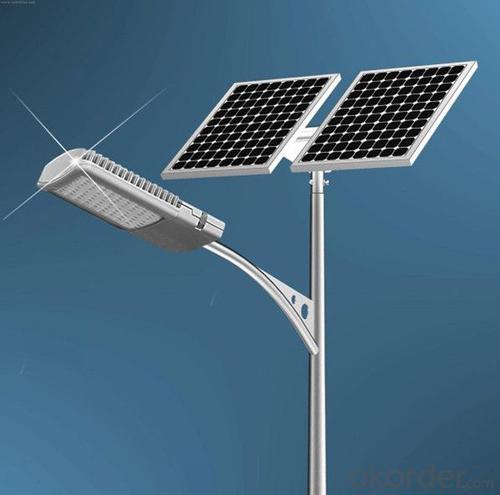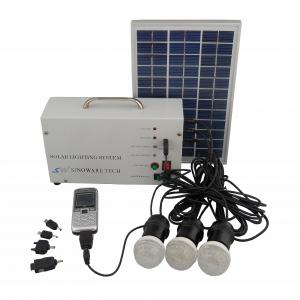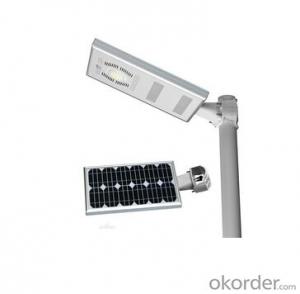Outdoor Motion Solar Light - Solar Street Light Environmental Friendly, Cost Saving, Top Class Quality 80R
- Loading Port:
- Ningbo
- Payment Terms:
- TT OR LC
- Min Order Qty:
- 1 set
- Supply Capability:
- 5000 set/month
OKorder Service Pledge
OKorder Financial Service
You Might Also Like
Step 1 – Find area in need of street lights
The first thing to figure out is the length of road in need of street lights. This can be a small entrance road only a couple hundred of feet long to miles of streets through an area. Does the area currently have any type of lighting available? What is the reason for needing street lights in this area?
Step 2 – Find out if electric is available
Is the electrical grid already nearby or would you need to call in the power company to bring in electrical lines? If the electric needs to be brought to the area, how much is this going to cost? Depending on how far the grid electric is from the location of the needed lighting, this can be quite expensive.



Step 3 – Determine the lighting requirements
How much lighting is needed on the street? Do the lights need to be dark sky compliant? Do the street lights need to run from dusk to dawn or for only a specified number of hours at night? Are the street lights able to dim in the middle of the night and still provide enough lighting? These questions need to be answered before you can decide on how many lights you will need to complete the project.
Step 4 – Find all alternatives
Solar power street lights are an option to traditional electrical lights. Solar street lights do not need the electrical grid to be brought in as they are self-contained units that provide their own electric.The best lighting solution by using lower amounts of power, better optics, dimming features where needed, and cost less in an overall solution.
Step 5 – Contact companies for quotes
The last step after gathering the above information is to contact companies for quotes. Just like with anything else, get multiple quotes and weigh the pros and cons of every company and situation. The lowest quote is not always the best, so make sure to do your research on companies and products before you submit a purchase order.
If you take your time, do your research, and gather needed requirements, your next street lighting project will be a success. Never be afraid to ask a lot questions, they may save you time and money in the long run.
- Q: Do solar lights have adjustable height or mounting options?
- Yes, solar lights often have adjustable height or mounting options. Many solar lights come with adjustable poles or stakes that allow you to easily adjust the height of the light according to your preference or the specific area you want to illuminate. Additionally, some solar lights have multiple mounting options, such as wall mounts or ground stakes, giving you the flexibility to install them in various locations. These adjustable height and mounting options make solar lights versatile and suitable for different outdoor lighting needs.
- Q: Can solar lights be used for basketball court lighting?
- Yes, solar lights can be used for basketball court lighting. Solar lights are an eco-friendly and cost-effective option for illuminating outdoor spaces, including basketball courts. They harness energy from the sun and store it in batteries, which can power the lights during nighttime games or practices. They provide sufficient lighting for players and spectators, while reducing electricity costs and minimizing environmental impact.
- Q: How do solar lights compare to traditional electric lights?
- Solar lights and traditional electric lights have their own unique advantages and disadvantages, making them suitable for different purposes. When considering cost, solar lights have a higher initial investment since they require the purchase of solar panels and batteries. However, they do not have any ongoing electricity costs, making them more economical in the long term. In contrast, traditional electric lights have lower upfront costs but can be more expensive to operate due to monthly electricity bills. In terms of installation, solar lights are generally easier to set up as they do not require complex wiring or access to an electrical grid. This makes them an excellent choice for remote areas or places without reliable electricity infrastructure. On the other hand, traditional electric lights require professional installation and access to electrical outlets or wiring, which can be more difficult and time-consuming. Both types of lights offer different levels of brightness and performance. Traditional electric lights typically have higher lumen output and are better suited for areas that require bright lighting, such as commercial or industrial spaces. Solar lights may have lower lumen output but are still appropriate for areas that need moderate or accent lighting, like residential gardens or pathways. One major advantage of solar lights is their environmental sustainability. They utilize renewable energy from the sun, reducing dependence on fossil fuels and decreasing carbon emissions. Additionally, solar lights do not contribute to light pollution since they only emit focused light where it is needed. In contrast, traditional electric lights rely on electricity generated from various sources, which may include non-renewable energy and contribute to light pollution. When it comes to maintenance, solar lights require periodic cleaning of the solar panels to ensure optimal performance. They also need occasional battery replacement after several years. Traditional electric lights may require more frequent maintenance, such as replacing bulbs or repairing electrical connections. Ultimately, the choice between solar lights and traditional electric lights depends on the specific requirements of the application. Solar lights are a more sustainable and cost-effective option for remote or off-grid locations, while traditional electric lights are better suited for areas that require high brightness and have reliable access to electricity.
- Q: Are solar lights suitable for use in gardens or flower beds?
- Yes, solar lights are suitable for use in gardens or flower beds. They are eco-friendly, easy to install, and provide a decorative and functional lighting solution for outdoor spaces.
- Q: Can solar lights be used for outdoor bus stops or shelters?
- Yes, solar lights can be used for outdoor bus stops or shelters. Solar lights are an excellent option for outdoor lighting in such areas as they are easy to install, require minimal maintenance, and can provide sufficient illumination without the need for electrical wiring. Additionally, solar lights are cost-effective and environmentally friendly, harnessing energy from the sun to power the lights.
- Q: Do solar lights have a backup power option during prolonged cloudy days?
- No, solar lights typically do not have a backup power option during prolonged cloudy days. Solar lights rely on sunlight to generate electricity through photovoltaic cells, which is stored in rechargeable batteries for use at night. During cloudy days, the amount of sunlight available is significantly reduced, leading to a decrease in the charging capacity of the batteries. As a result, the lights may not last as long or may not function at all during extended periods of cloud cover. However, some solar lights may have larger battery capacities or more efficient solar panels, which can provide better performance during cloudy days. Additionally, certain models may have the option to connect to an external power source, such as an electrical outlet, for charging during unfavorable weather conditions.
- Q: Are solar lights durable?
- Yes, solar lights are generally durable. They are designed to withstand outdoor conditions such as rain, snow, and heat. However, the durability may vary depending on the quality and brand of the solar light. It is recommended to choose solar lights that are made with high-quality materials to ensure long-lasting durability.
- Q: Can solar lights be used for remote or off-grid cabins?
- Yes, solar lights can definitely be used for remote or off-grid cabins. Since solar lights are powered by the sun, they do not require access to the electrical grid and can be an excellent alternative for lighting in remote locations. They offer a sustainable and cost-effective solution, providing ample illumination without the need for traditional electricity sources.
- Q: Can solar lights be used for outdoor security cameras?
- Yes, solar lights can be used for outdoor security cameras. Solar lights provide a reliable and sustainable source of power, allowing outdoor security cameras to function effectively without the need for traditional electrical connections. This makes them a convenient and cost-effective option for enhancing security in outdoor areas.
- Q: Can solar lights be used for lighting up outdoor public spaces or parks?
- Yes, solar lights can definitely be used for lighting up outdoor public spaces or parks. In fact, they are becoming increasingly popular for these applications due to their numerous advantages. Solar lights are powered by sunlight, which means they do not require any electricity from the grid, making them a cost-effective and environmentally friendly lighting solution. Outdoor public spaces and parks often have a lot of open area and receive a considerable amount of sunlight throughout the day. This makes them ideal locations for solar lights, as they can harness the sun's energy and convert it into electricity to power the lights during the night. By utilizing solar lights in these areas, cities and municipalities can save on energy costs and reduce their carbon footprint. Solar lights are also easy to install and maintain. They do not require any extensive wiring or underground cables, which can be expensive and time-consuming. This makes them a convenient choice for lighting up large outdoor spaces, as they can be easily installed in various locations without the need for extensive infrastructure. Additionally, solar lights are equipped with advanced technology that allows them to automatically adjust their brightness based on the surrounding conditions. This ensures that the lights are not too dim or too bright, providing optimal lighting for outdoor public spaces and parks. Some solar lights also come with motion sensors, which can further enhance security by automatically brightening when someone approaches. In summary, solar lights are a great option for lighting up outdoor public spaces or parks. They are cost-effective, environmentally friendly, easy to install and maintain, and can provide adequate lighting throughout the night. By utilizing solar lights in these areas, cities and municipalities can save energy and contribute to a greener future.
Send your message to us
Outdoor Motion Solar Light - Solar Street Light Environmental Friendly, Cost Saving, Top Class Quality 80R
- Loading Port:
- Ningbo
- Payment Terms:
- TT OR LC
- Min Order Qty:
- 1 set
- Supply Capability:
- 5000 set/month
OKorder Service Pledge
OKorder Financial Service
Similar products
Hot products
Hot Searches
Related keywords


























